Related Research Articles
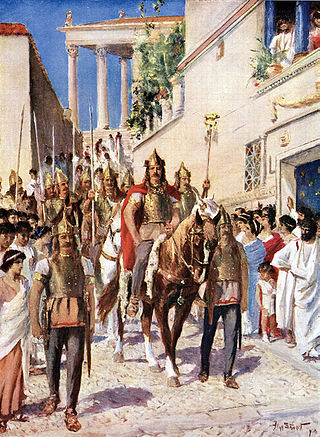
Alaric I was the first king of the Visigoths, from 395 to 410. He rose to leadership of the Goths who came to occupy Moesia—territory acquired a couple of decades earlier by a combined force of Goths and Alans after the Battle of Adrianople.

The Battle of Abritus, also known as the Battle of Forum Terebronii, occurred near Abritus in the Roman province of Moesia Inferior in the summer of 251. It was fought between the Romans and a federation of Gothic and Scythian tribesmen under the Gothic king Cniva. The Roman army of three legions was soundly defeated, and Roman emperors Decius and his son Herennius Etruscus were both killed in battle. They became the first Roman emperors to be killed by a foreign enemy. It was one of the worst defeats suffered by the Roman Empire against the Germanic tribes, rated by the Roman historian Ammianus Marcellinus as on par with the Battle of the Teutoburg Forest in 9 AD, the Marcomannic invasion of Roman Italy in 170, and the Battle of Adrianople in 378.

The Goths were a Germanic people who played a major role in the fall of the Western Roman Empire and the emergence of medieval Europe.

Theodoricthe Great, also called Theodoric the Amal, was king of the Ostrogoths (471–526), and ruler of the independent Ostrogothic Kingdom of Italy between 493 and 526, regent of the Visigoths (511–526), and a patrician of the Eastern Roman Empire. As ruler of the combined Gothic realms, Theodoric controlled an empire stretching from the Atlantic Ocean to the Adriatic Sea. Though Theodoric himself only used the title 'king' (rex), some scholars characterize him as a Western Roman Emperor in all but name, since he ruled large parts of the former Western Roman Empire, had received the former Western imperial regalia from Constantinople in 497, and was referred to by the title augustus by some of his subjects.

The Visigoths were an early Germanic people who, along with the Ostrogoths, constituted the two major political entities of the Goths within the Roman Empire in late antiquity, or what is known as the Migration Period. The Visigoths emerged from earlier Gothic groups, including a large group of Thervingi, who had moved into the Roman Empire beginning in 376 and had played a major role in defeating the Romans at the Battle of Adrianople in 378. Relations between the Romans and the Visigoths varied, with the two groups making treaties when convenient, and warring with one another when not. Under their first leader, Alaric I, the Visigoths invaded Italy and sacked Rome in August 410. Afterwards, they began settling down, first in southern Gaul and eventually in Hispania, where they founded the Visigothic Kingdom and maintained a presence from the 5th to the 8th centuries AD.

Dacia was the land inhabited by the Dacians, its core in Transylvania, stretching to the Danube in the south, the Black Sea in the east, and the Tisza in the west. The Carpathian Mountains were located in the middle of Dacia. It thus roughly corresponds to the present-day countries of Romania, as well as parts of Moldova, Bulgaria, Serbia, Hungary, Slovakia, and Ukraine.
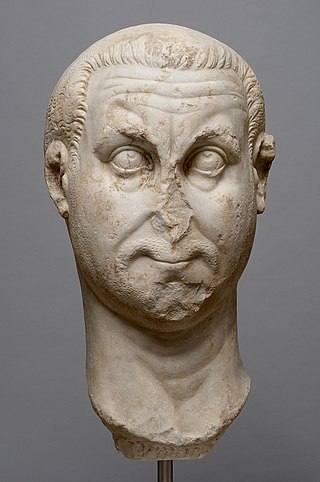
Valerius Licinianus Licinius was Roman emperor from 308 to 324. For most of his reign he was the colleague and rival of Constantine I, with whom he co-authored the Edict of Milan, AD 313, that granted official toleration to Christians in the Roman Empire. He was finally defeated at the Battle of Chrysopolis, and was later executed on the orders of Constantine I.

Gratian was emperor of the Western Roman Empire from 367 to 383. The eldest son of Valentinian I, Gratian accompanied his father on several campaigns along the Rhine and Danube frontiers and was raised to the rank of Augustus in 367. Upon the death of Valentinian in 375, Gratian took over government of the west while his half-brother Valentinian II was also acclaimed emperor in Pannonia. Gratian governed the western provinces of the empire, while his uncle Valens was already the emperor over the east.
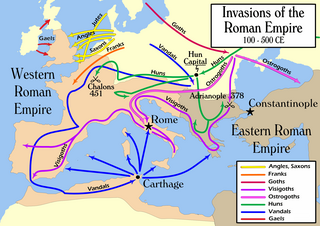
The Migration Period, also known as the Barbarian Invasions, was a period in European history marked by large-scale migrations that saw the fall of the Western Roman Empire and subsequent settlement of its former territories by various tribes, and the establishment of the post-Roman kingdoms. The term refers to the important role played by the migration, invasion, and settlement of various tribes, notably the Franks, Goths, Alemanni, Alans, Huns, early Slavs, Pannonian Avars, Magyars, and Bulgars within or into the former Western Empire and Eastern Europe. The period is traditionally taken to have begun in AD 375 and ended in 568. Various factors contributed to this phenomenon of migration and invasion, and their role and significance are still widely discussed.
Foederati were peoples and cities bound by a treaty, known as foedus, with Rome. During the Roman Republic, the term identified the socii, but during the Roman Empire, it was used to describe foreign states, client kingdoms or barbarian tribes to which the empire provided benefits in exchange for military assistance. The term was also used, especially under the empire, for groups of "barbarian" mercenaries of various sizes who were typically allowed to settle within the empire.
Teia, also known as Teja, Theia, Thila, Thela, and Teias, was the last Ostrogothic King of Italy. He led troops during the Battle of Busta Gallorum and had noncombatant Romans slaughtered in its aftermath. In late 552/early 553, he was killed during the Battle of Mons Lactarius. Archaeological records attesting to his rule show up in coinage found in former Transalpine Gaul.

Cniva was a Gothic king who invaded the Roman Empire. He successfully captured the city of Philippopolis in 250 and killed Emperor Decius and his son Herennius Etruscus at the Battle of Abritus as he was attempting to leave the Empire in 251. This was the first time a Roman Emperor had been killed in combat against foreigners. He was allowed by the new Emperor Trebonianus Gallus to leave with his spoils and was paid tribute to stay out of the empire.

The sack of Rome on 24 August 410 AD was undertaken by the Visigoths led by their king, Alaric. At that time, Rome was no longer the capital of the Western Roman Empire, having been replaced in that position first by Mediolanum in 286 and then by Ravenna in 402. Nevertheless, the city of Rome retained a paramount position as "the eternal city" and a spiritual center of the Empire. This was the first time in almost 800 years that Rome had fallen to a foreign enemy, and the sack was a major shock to contemporaries, friends and foes of the Empire alike.
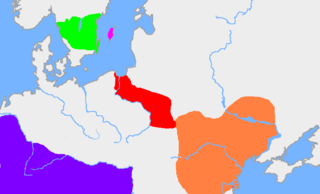
The Thervingi, Tervingi, or Teruingi were a Gothic people of the plains north of the Lower Danube and west of the Dniester River in the 3rd and the 4th centuries.

The Taifals or Tayfals were a people group of Germanic or Sarmatian origin, first documented north of the lower Danube in the mid third century AD. They experienced an unsettled and fragmented history, for the most part in association with various Gothic peoples, and alternately fighting against or for the Romans. In the late fourth century some Taifali were settled within the Roman Empire, notably in western Gaul in the modern province of Poitou. They subsequently supplied mounted units to the Roman army and continued to be a significant source of cavalry for early Merovingian armies. By the sixth century their region of western Gaul had acquired a distinct identity as Thifalia.
Vidigoia was a Thervingian Gothic warrior. His name means either "the man from the forest zone" or "the forest-barker/wolf".
Kindins is a Gothic word that is identified by some scholars as the vernacular title for what may have been a political or judicial position among the 4th century Goths, identified in Greek and Latin sources as a "judge". Patrick J. Geary described the position as a "super-royal judge".
Aoric was a Thervingian Gothic king who lived in the 4th century. Aoric was son of Ariaric and father of Athanaric, he was raised in Constantinople, where a statue was erected in his honour. He was recorded by Auxentius of Durostorum leading a persecution of Gothic Christians in 347/348. Herwig Wolfram noted that "alliteration, variation, and rhythm in the line of names Athanaric, Aoric, Ariaric resemble the 'ideal type' of Hadubrand, Hildebrand, Heribrand". He considered the similarities and comparison suggested that all three kings were members of the Balti dynasty.

The German and Sarmatian campaigns of Constantine were fought by the Roman Emperor Constantine I against the neighbouring Germanic peoples, including the Franks, Alemanni and Goths, as well as the Sarmatian Iazyges, along the whole Roman northern defensive system to protect the empire's borders, between 306 and 336.
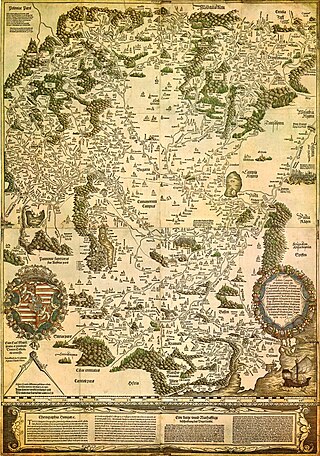
The timeline of Hungarian history lists the important historical events that took place in the territory of Hungary or are closely connected to the history of the country.
References
- ↑ Carole M. Cusack (1998). Rise of Christianity in Northern Europe, 300-1000. Continuum International Publishing Group. pp. 38–. ISBN 978-0-304-70735-5 . Retrieved 6 January 2013.
- ↑ Herwig Wolfram; Thomas J. Dunlap (1 March 1990). History of the Goths. University of California Press. pp. 61–. ISBN 978-0-520-06983-1 . Retrieved 6 January 2013.
- 1 2 Noel Emmanuel Lenski (2002). Failure of Empire: Valens and the Roman State in the Fourth Century A.D. University of California Press. pp. 120–. ISBN 978-0-520-23332-4 . Retrieved 6 January 2013.
- ↑ Jordanes, Getica .
- ↑ From Roman Provinces to Medieval Kingdoms. Thomas F. X. Noble. ed. 2006, p.245
- 1 2 Patrick J. Geary (2003). The Myth of Nations: The Medieval Origins of Europe. Princeton University Press. pp. 87–. ISBN 978-0-691-11481-1 . Retrieved 6 January 2013.